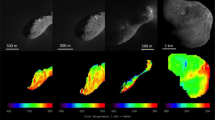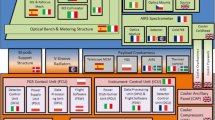Abstract
AKARI, formerly known as ASTRO-F, is the second Japanese space mission to perform infrared astronomical observations. AKARI was launched on 21 February 2006 (UT) and brought into a sun-synchronous polar orbit at an altitude of 700 km by a JAXA M-V rocket. AKARI has a telescope with a primary-mirror aperture size of 685 mm together with two focal-plane instruments on board: the Infrared Camera (IRC), which covers the spectral range 2–26 μm and the Far-Infrared Surveyor (FIS), which operates in the range 50–180 μm. The telescope mirrors are made of sandwich-type silicon carbide, specially developed for AKARI. The focal-plane instruments and the telescope are cooled by a unique cryogenic system that kept the telescope at 6K for 550 days with 180 l super-fluid liquid Helium (LHe) with the help of mechanical coolers on board. Despite the small telescope size, the cold environment and the state-of-the-art detectors enable very sensitive observations at infrared wavelengths. To take advantage of the characteristics of the sun-synchronous polar orbit, AKARI performed an all-sky survey during the LHe holding period in four far-infrared bands with FIS and two mid-infrared bands with IRC, which surpasses the IRAS survey made in 1983 in sensitivity, spatial resolution, and spectral coverage. AKARI also made over 5,000 pointing observations at given targets in the sky for approximately 10 min each, for deep imaging and spectroscopy from 2 to 180 μm during the LHe holding period. The LHe ran out on 26 August 2007, since which date the telescope and instrument are still kept around 40K by the mechanical cooler on board, and near-infrared imaging and spectroscopic observations with IRC are now being continued in pointing mode.







Similar content being viewed by others
References
Murakami, H.: ASTRO-F infrared sky survey mission. Proc. SPIE 5487, 330 (2004)
Shibai, H.: AKARI (ASTRO-F): Flight performance and preliminary results. Adv. Space Res. 40, 595 (2007)
Murakami, H., et al.: The IRTS (Infrared Telescope in Space) mission. PASJ 48, L41 (1996)
Murakami, H., et al.: The infrared astronomical mission AKARI. PASJ 59, S369 (2007)
Kaneda, H., et al.: In-orbit focal adjustment of the AKARI telescope with Infrared Camera (IRC) images. PASJ 59, S423 (2007)
Onaka, T., et al.: The Infrared Camera (IRC) for AKARI – design and imaging performance. PASJ 59, S401 (2007)
Kawada, M., et al.: The Far-Infrared Surveyor (FIS) for AKARI. PASJ 59, S389 (2007)
Nakagawa, T., et al.: Flight performance of the AKARI cryogenic system. PASJ 59, S377
Neugebauer, G., et al.: The Infrared Astronomical Satellite (IRAS) mission. ApJL 278, L1 (1984)
Kaneda, H., Onaka, T., Kawada, M., Murakami, H.: Cryogenic optical testing of sandwich-type silicon carbide mirrors. Appl. Opt. 42, 708 (2003)
Kaneda, H., et al.: Cryogenic optical performance of the ASTRO-F SiC telescope. Appl. Opt. 44, 6823 (2005)
Onaka, T., et al.: In-orbit focal adjustment of the AKARI telescope with and without liquid helium cryogen. Proc. SPIE 7010, 70102X (2008)
Ohyama, Y., et al.: Near-Infrared and mid-infrared spectroscopy with the Infrared Camera (IRC) for AKARI. PASJ 59, S411 (2007)
Kawada, M., et al.: Performance of an imaging fourier transform spectrometer with photoconductive detector arrays: an application for the AKARI far-infrared instrument. PASJ 60, S389 (2008)
Ishihara, D., et al.: Mid-infrared all-sky survey with the Infrared Camera (IRC) on board the ASTRO-F satellite. PASP 118, 324 (2006)
Price, S. D., et al.: Midcourse space experiment survey of the galactic plane. AJ 121, 2819 (2001)
Ishihara, D., et al.: AKARI infrared imaging of reflection nebulae IC4954 and IC4955. PASJ 59, S443 (2007)
Kennicutt, Jr., R. C., et al.: SINGS: the SIRTF nearby galaxies survey. PASP 115, 928 (2003)
Engelbracht, C. W., et al.: Extended mid-infrared aromatic feature emission in M82. ApJ 642, L127 (2006)
Matsumoto, H. et al.: Detection of the unidentified infrared bands in a filament of the dwarf galaxy NGC1569. IAU Symp. 251, 259 (2008)
Suzuki, T., et al.: Spatial distributions of cold and warm interstellar dust in M101 resolved with AKARI/Far-Infrared Surveyor (FIS). PASJ 59, S473 (2007)
Sakon, I., et al.: Properties of newly formed dust by SN 2006JC based on near- to mid-infrared observation with AKARI. ApJ 692, 546 (2009)
Ita, Y., et al.: AKARI IRC survey of the large magellanic cloud: outline of the survey and initial results. PASJ 60, S435 (2008)
Shimonishi, T., et al.: AKARI near-infrared spectroscopy: detection of H2O and CO2 ices toward young stellar objects in the large magellanic cloud. ApJL 686, L99 (2008)
Acknowledgements
The authors thank all the members of the AKARI project for their contributions, without which such a successful mission would not have been made possible. AKARI is a JAXA project with the participation of ESA. This work is supported in part by Grants-in-Aid for Scientific Research from the Ministry of Education, Culture, Sports, Science, and Technology of Japan and from the Japan Society for the Promotion of Science.
Author information
Authors and Affiliations
Corresponding author
Rights and permissions
About this article
Cite this article
Onaka, T., Salama, A. AKARI: space infrared cooled telescope. Exp Astron 27, 9 (2009). https://doi.org/10.1007/s10686-009-9168-3
Received:
Accepted:
Published:
DOI: https://doi.org/10.1007/s10686-009-9168-3




